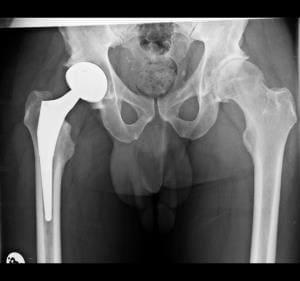Total Hip replacement
Approximately 80,000 hip replacements are performed annually in the UK and these numbers are increasing each year. The commonest reason to perform a THR is for osteoarthritis of the hip where the patient’s symptoms are now severe and interfering with quality of life (pain and disability).
What’s involved with a hip replacement?
Hip replacement involves a 3-day stay in hospital. You are admitted to hospital on the day of surgery (you will have had a pre-assessment within 2 weeks for blood tests and a medical examination). The operation is usually performed with a combination of spinal anaesthetic (legs numb from the waist down) and sedation (made to feel sleepy). The operation itself takes approximately 1 hour and you start walking when the spinal anaesthetic has worn off (usually the next day). The operation involves placing a new socket and stem into the pelvis and femur to create the new hip joint.
|
|
|
Recovery from a hip replacement
Physiotherapy starts on the first day after the operation. You will get up and be able to put all your weight on the operated leg (on day one you will use a Zimmer frame for balance). You will have regular physiotherapy whilst in hospital and will be discharged once you are safely using crutches, and are able to walk up and down stairs.
Physiotherapy will continue as an out patient and you will be discharged once your physiotherapist is happy with your progress. Patients can use crutches for 4-6 weeks afterwards, I recommend using them as long as you need them. You can drive once you are safely off the crutches.
Other specific precautions include not sitting in seats that are too low or lying on your side for 6 weeks after surgery (risk of dislocation).
Full recovery is around 3 months.
Complications of a hip replacement
Hip Replacement is a safe operation that dramatically improves the quality of one’s life. The are some complications;
Infection – the overall risk is around 1%. Antibiotics cannot penetrate an artificial material so the worst-case scenario is that the implant will need to be removed if infected.
Clots – Deep Vein Thrombosis and Pulmonary Embolism may occur in 2-3% of patients. All patients are placed on anticoagulants (blood-thinners) for 42 days after surgery to minimise the risk.
Dislocation – This may occur in 1-2% of patients and is due to incorrect positioning of the implants, or over-reaching / bending to lever out the implant. The risk is highest in the first 3 months (hence precautions after surgery).
Damage to nerves or blood vessels – This is very rare (less than 1%) and may result in a foot drop if the sciatic nerve is damaged.
Leg-length inequality – This is rare (less than 1%) and is commonest if there is some pre-existing abnormality (e.g. pre-existing leg length inequality from a childhood hip condition, or if there is a tilt in the pelvis).
Bleeding – Excessive bleeding may occur at the time if surgery and this may require a blood transfusion. Sometimes there can be bleeding after surgery (due to the blood thinners) and this can cause swelling around the hip.
Fracture – In very rare instances, there may be a fracture to the bones that occurs during or after a hip replacement (peri-prosthetic fracture).
Loosening – Hip replacements do not last forever. Rough estimates of around 15 years are quoted, the newer implants and bearing surfaces should last longer, although long-term data is required. One of the best guides is to ask your surgeon the ODEP rating of the implant. Detailed information and implant survivorship can be given using this rating.
Ongoing pain – sometimes there can be on-going pain following a hip replacement. This may be due to structures around the hip, e.g. the muscles, or referred pain from the spine.
How long will my hip last?
Hip replacement has the best outcomes out of all the joint replacements performed.
Most hip replacements will last a minimum of 10-15 years although the newer materials will last longer. All implants have an ODEP (Orthopaedic Data Evaluation Panel) rating and this gives a guide to the survival of each type of implant. The best implants have a 10A* rating; this means that 95% of these types of implant are still working at 10 years after surgery.

